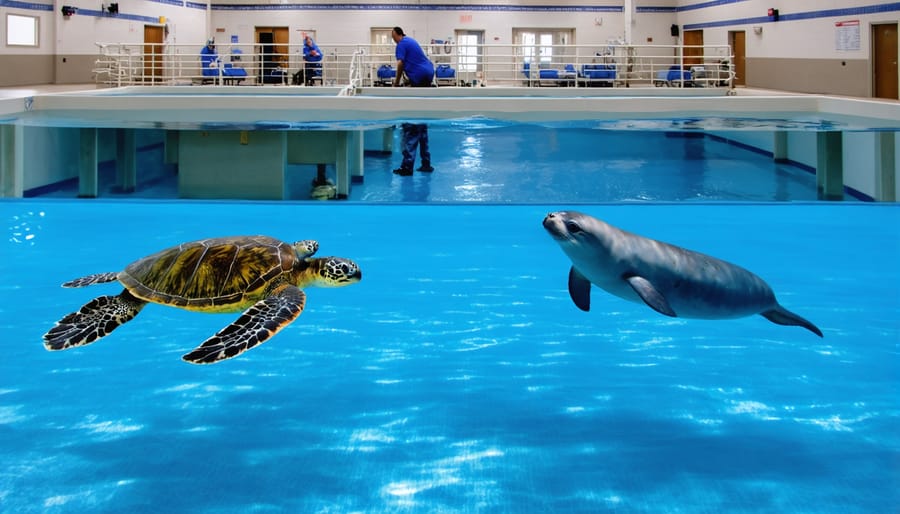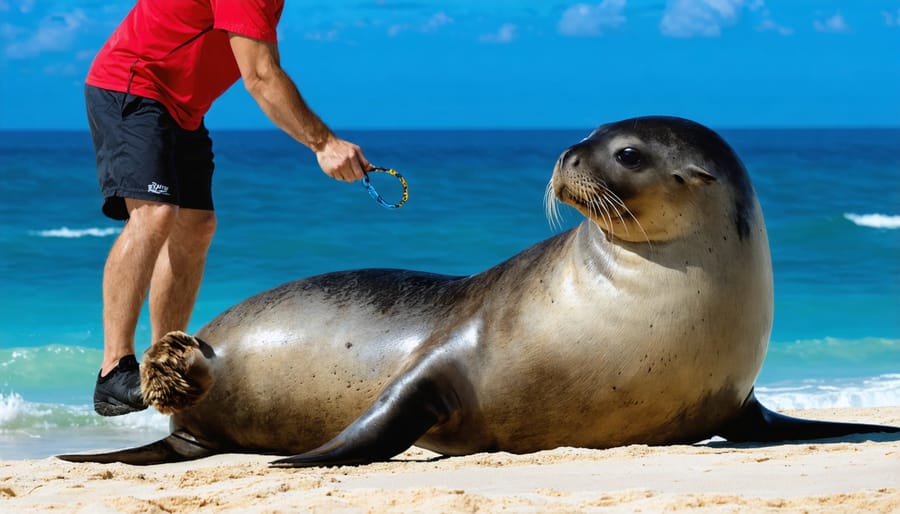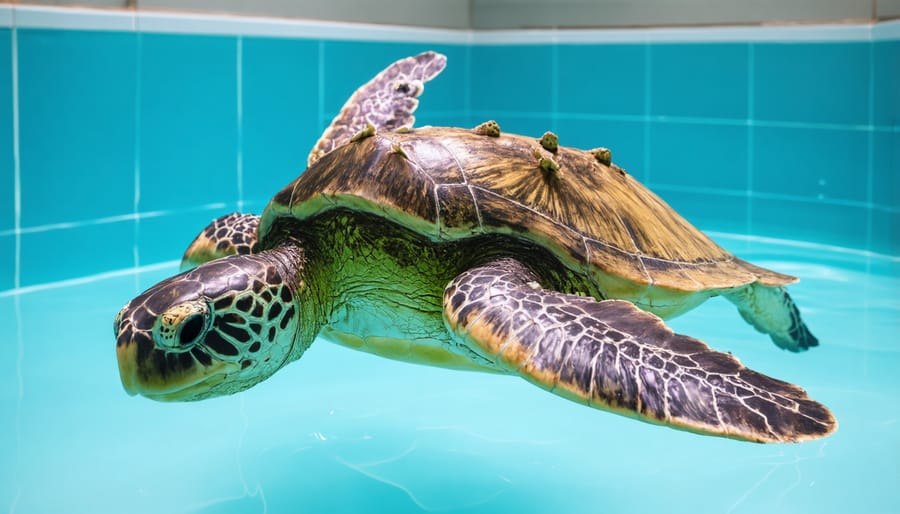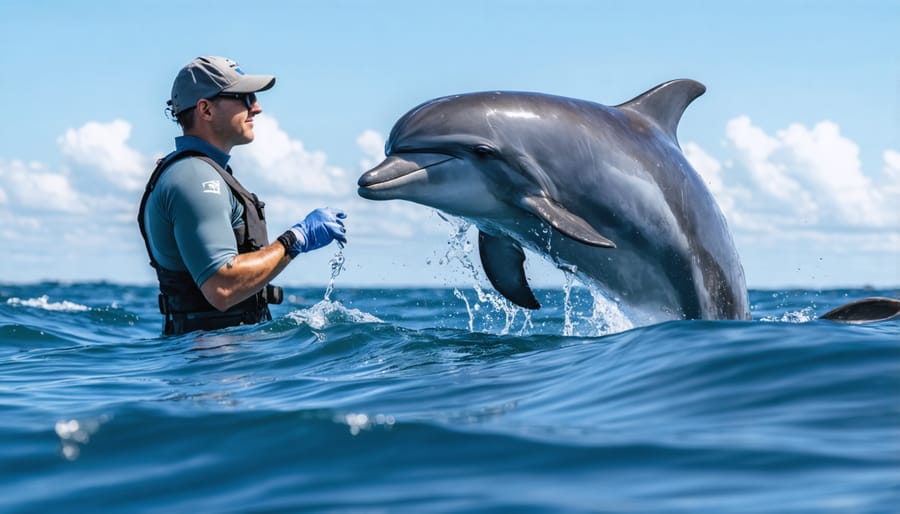
Marine rehabilitation centers stand as beacons of hope in modern marine conservation efforts, serving as crucial lifelines for injured, sick, and stranded marine animals across the globe. These specialized facilities combine cutting-edge veterinary care with decades of marine biology expertise to heal and restore marine wildlife to their natural habitats. From treating oil-slicked sea otters to rehabilitating injured sea turtles and providing critical care for stranded dolphins, these centers represent humanity’s commitment to protecting our ocean’s most vulnerable inhabitants.
Working round the clock, dedicated teams of marine biologists, veterinarians, and trained volunteers transform these facilities into emergency rooms for marine life, equipped with specialized pools, medical laboratories, and rehabilitation tanks. Their work extends beyond immediate medical care, encompassing crucial research that advances our understanding of marine species and their recovery processes. Through careful documentation and innovative treatment methods, these centers not only save individual animals but also contribute valuable data to global marine conservation strategies.
The success stories emerging from these facilities – from rescued seal pups returning to the wild to critically endangered species given a second chance at survival – demonstrate the vital role these centers play in preserving marine biodiversity for future generations.
Core Behavioral Therapy Techniques in Marine Rehabilitation
Positive Reinforcement Training
Positive reinforcement training plays a crucial role in rehabilitating injured marine animals, helping them develop essential survival skills while maintaining their natural behaviors. This approach relies on rewarding desired behaviors with food, praise, or enrichment activities, creating a trusting relationship between animals and their caregivers.
Marine rehabilitation specialists typically begin with basic trust-building exercises, offering rewards when animals approach designated areas or respond to specific signals. For injured seals and sea lions, trainers might reward them for voluntarily participating in medical procedures, making future treatments less stressful for both the animals and staff.
Dr. Maria Chen, a veteran marine mammal trainer, explains, “We use target training extensively with our patients. By teaching them to follow a specific object, we can guide them through medical examinations without force, reducing their anxiety and accelerating their recovery process.”
The training process also helps maintain the animals’ wild instincts. For instance, injured dolphins learn to catch live fish in specialized pools before release, ensuring they haven’t lost their hunting abilities during rehabilitation. This careful balance between human care and maintaining natural behaviors is essential for successful rehabilitation and release.
Rehabilitation centers often incorporate environmental enrichment into their training programs, using toys, puzzles, and other stimuli to keep animals mentally engaged while developing physical skills. This comprehensive approach ensures that animals remain active and alert throughout their recovery, improving their chances of survival upon release.

Environmental Enrichment Strategies
Environmental enrichment plays a crucial role in the rehabilitation of marine animals, helping them maintain natural behaviors and reduce stress during their recovery. Rehabilitation centers design specialized environments that simulate natural habitats while providing stimulating experiences for their patients.
Physical enrichment includes the strategic placement of artificial kelp forests, rocks, and substrate materials that encourage natural foraging behaviors. For larger marine mammals, floating platforms and varied depth pools allow them to practice diving and swimming patterns essential for their eventual return to the wild.
Centers often implement feeding enrichment techniques, such as puzzle feeders and scattered food distribution, which promote problem-solving skills and natural hunting behaviors. For instance, octopuses receive food hidden inside specially designed containers that they must manipulate to access their meals, keeping their cognitive abilities sharp.
Social enrichment is equally important, particularly for species that naturally live in groups. When appropriate, rehabilitating animals are housed together to maintain social skills and reduce isolation stress. However, careful consideration is given to compatibility and disease prevention protocols.
Sensory enrichment through underwater acoustics, varying water currents, and temperature gradients helps maintain the animals’ natural responses to environmental cues. Some facilities even use underwater speakers to play recorded ocean sounds, creating a more authentic environment for recovering marine life.
These enrichment strategies are regularly evaluated and modified based on each animal’s response and recovery progress, ensuring the best possible outcomes for their eventual release back into the wild.
Species-Specific Rehabilitation Programs
Marine Mammal Rehabilitation
Marine mammal rehabilitation represents a critical component of wildlife conservation efforts, focusing primarily on the recovery and release of seals, sea lions, and dolphins. Understanding marine mammal behavior patterns is essential for successful rehabilitation outcomes. These centers employ specialized techniques tailored to each species’ unique needs and challenges.
For seals and sea lions, rehabilitation often begins with addressing dehydration and malnutrition, common issues in stranded animals. Treatment protocols typically include fluid therapy, specialized feeding programs, and careful monitoring of vital signs. Young pups, particularly those separated from their mothers, require intensive care including bottle-feeding with specially formulated milk replacers.
Dolphin rehabilitation presents unique challenges due to their complex social nature and specialized physiological needs. Centers utilize custom-designed pools with controlled environments to support recovery from injuries, illness, or stranding events. Medical care often involves collaborative efforts between veterinarians, marine biologists, and animal care specialists.
Success in marine mammal rehabilitation relies heavily on minimizing human contact while maintaining essential care. This approach ensures animals retain their wild instincts and can successfully reintegrate into their natural habitats upon release. Centers employ enrichment activities that simulate natural behaviors and feeding patterns, crucial for maintaining physical and mental health during recovery.
Release preparation includes thorough health assessments, behavioral evaluations, and sometimes satellite tagging to monitor post-release success. Many facilities also participate in research programs, contributing valuable data to our understanding of marine mammal health and conservation needs.
Sea Turtle Recovery Programs
Marine rehabilitation centers employ specialized techniques and protocols for sea turtle recovery, addressing various injuries and conditions these magnificent creatures face. Common treatments include shell repair using marine-grade epoxy for cracked carapaces, antibiotic therapy for infections, and specialized float therapy for buoyancy issues.
Rehabilitation specialists first conduct comprehensive health assessments, including blood work, radiographs, and ultrasounds to determine the extent of injuries. Critical care protocols often involve maintaining precise water temperatures, administering fluid therapy, and providing carefully calculated nutrition plans tailored to each species and condition.
For turtles affected by fishing gear entanglement, veterinarians perform delicate surgeries to remove hooks and lines, followed by intensive wound care and monitoring. Those suffering from cold-stunning receive gradual temperature adjustment treatments in specialized tanks, with vital signs closely monitored during the warming process.
Physical therapy plays a crucial role in rehabilitation, with custom-designed exercise programs helping turtles regain strength and mobility. Innovative techniques include underwater treadmills and assisted swimming sessions using specially designed harnesses.
Success stories from these programs are remarkable, with many centers achieving release rates above 70%. Before release, turtles must demonstrate normal feeding behavior, proper diving abilities, and sustainable weight gain. Some facilities attach satellite tags to released turtles, providing valuable data about post-rehabilitation survival rates and migration patterns.
These recovery efforts not only save individual turtles but also contribute significantly to species conservation through research, education, and public awareness initiatives. Many centers collaborate with volunteer networks and citizen scientists to monitor released turtles and document their progress in the wild.

Measuring Rehabilitation Success
Behavioral Assessment Criteria
Marine rehabilitation centers employ a comprehensive set of behavioral assessment criteria to monitor and evaluate the recovery progress of their patients. These indicators help determine when an animal is ready for release back into the wild.
Key behavioral markers include feeding patterns, social interactions, and physical capabilities. Staff closely observe whether animals can successfully catch and consume live prey, maintain proper diving depths, and demonstrate natural foraging behaviors. For marine mammals, assessments include their ability to navigate effectively, maintain proper body temperature, and exhibit species-specific social behaviors.
Swimming patterns and mobility are crucial indicators, with rehabilitators monitoring an animal’s ability to maintain buoyancy, execute smooth directional changes, and demonstrate normal swimming speeds. For sea turtles, this includes proper flipper coordination and surface breathing patterns.
Stress responses and environmental adaptation are equally important. Animals must show appropriate reactions to natural stimuli and maintain healthy sleep-wake cycles. They should display natural wariness of humans and other potential predators, ensuring their survival post-release.
Documentation occurs through standardized assessment forms, video monitoring, and regular veterinary evaluations. These observations help create individual rehabilitation plans and determine release readiness. Centers typically require animals to meet 80-90% of their species’ normal behavioral benchmarks before considering release, ensuring the highest possible chance of survival in the wild.
Post-Release Monitoring
Post-release monitoring is a critical component of marine rehabilitation success, allowing centers to evaluate their methods and ensure the long-term survival of released animals. Modern post-release monitoring techniques combine traditional and innovative technologies to track rehabilitated marine life.
Satellite tags and GPS tracking devices are commonly attached to larger species like sea turtles, dolphins, and seals, providing real-time data about their movements, diving patterns, and habitat usage. For smaller animals, passive integrated transponder (PIT) tags offer a way to identify individuals when they’re encountered again by researchers or stranding networks.
Acoustic telemetry has become increasingly valuable, using underwater receivers to track tagged animals as they move through marine environments. This technology helps researchers understand migration patterns and survival rates while identifying potential challenges in their natural habitat.
Photo-identification databases enable scientists to monitor released animals through distinctive markings or scars, particularly useful for species like dolphins and whales. Citizen science programs also play a crucial role, with trained volunteers reporting sightings and documenting behaviors of released animals.
Success metrics typically include survival rates, breeding success, and integration with wild populations. Centers maintain detailed records of post-release observations, which help refine rehabilitation protocols and improve future release outcomes. This data contributes to broader marine conservation efforts and helps justify the resources invested in rehabilitation programs.

The Human Element in Marine Rehabilitation
The success of marine rehabilitation centers hinges significantly on the dedication and expertise of their human caretakers, who must maintain a delicate balance between providing necessary care and minimizing human interaction. These skilled professionals, including marine biologists, veterinarians, and trained rehabilitators, work tirelessly to ensure that rescued animals maintain their wild instincts and natural behaviors.
Rehabilitators follow strict protocols designed to prevent animals from becoming habituated to human presence. This includes using visual barriers during feeding, limiting direct contact to essential medical procedures, and avoiding unnecessary verbal communication near the animals. These measures are crucial for ensuring that rehabilitated creatures can successfully reintegrate into their natural habitats upon release.
Volunteers play an integral role in marine rehabilitation centers, providing essential support while adhering to strict guidelines. Their duties often include food preparation, facility maintenance, and administrative tasks, all conducted with minimal direct animal contact. This approach helps maintain the professional standard of care while allowing passionate individuals to contribute meaningfully to marine conservation efforts.
The emotional investment of caregivers must be carefully managed. While it’s natural to develop attachment to the animals under their care, professionals must maintain objective decision-making capabilities. This emotional balance is particularly important when determining release readiness or making difficult end-of-life decisions.
Training programs for staff and volunteers emphasize the importance of maintaining professional distance while providing compassionate care. These programs often include courses on animal behavior, stress recognition, and proper handling techniques. Regular workshops and mentoring sessions help ensure that all team members understand and maintain appropriate boundaries with their marine patients.
Success in marine rehabilitation is measured not by how well animals adapt to human care, but by how effectively they can return to their natural environments. The human element, while essential, must remain nearly invisible to the animals throughout their rehabilitation journey, ensuring their best chance at successful release and survival in the wild.
Behavioral therapy has proven to be a cornerstone of successful marine rehabilitation, transforming how we approach the recovery and release of injured marine animals. Through careful observation and innovative treatment methods, rehabilitation centers have achieved remarkable success rates in returning animals to their natural habitats. These achievements highlight the importance of understanding and working with animal behavior rather than against it.
The integration of behavioral therapy with traditional veterinary care has led to breakthroughs in treating complex cases, particularly with marine mammals suffering from trauma or long-term captivity. Centers worldwide report that animals receiving behavioral intervention alongside medical treatment show faster recovery times and better adaptation skills upon release.
Looking ahead, the field of marine rehabilitation continues to evolve. Advanced monitoring technologies and data analytics are enabling more precise tracking of behavioral patterns and treatment outcomes. Emerging research suggests that incorporating virtual reality and automated enrichment systems could further enhance rehabilitation programs, particularly for species that are challenging to treat using conventional methods.
The future of marine rehabilitation lies in collaboration and knowledge sharing among centers globally. As climate change and human activities continue to impact marine ecosystems, the role of rehabilitation centers becomes increasingly crucial. By focusing on behavioral therapy and advancing our understanding of marine animal psychology, these centers not only save individual animals but contribute vital data to conservation efforts worldwide.
Through continued research, innovation, and dedication, marine rehabilitation centers stand as beacons of hope for injured marine life and the future of our oceans.
jessica
Ava Singh is an environmental writer and marine sustainability advocate with a deep commitment to protecting the world's oceans and coastal communities. With a background in environmental policy and a passion for storytelling, Ava brings complex topics to life through clear, engaging content that educates and empowers readers. At the Marine Biodiversity & Sustainability Learning Center, Ava focuses on sharing impactful stories about community engagement, policy innovations, and conservation strategies. Her writing bridges the gap between science and the public, encouraging people to take part in preserving marine biodiversity. When she’s not writing, Ava collaborates with local initiatives to promote eco-conscious living and sustainable development, ensuring her work makes a difference both on the page and in the real world.
